The AMD A8-7650K APU Review, Also New Testing Methodology
by Ian Cutress on May 12, 2015 10:00 AM ESTOffice Performance
The dynamics of CPU Turbo modes, both Intel and AMD, can cause concern during environments with a variable threaded workload. There is also an added issue of the motherboard remaining consistent, depending on how the motherboard manufacturer wants to add in their own boosting technologies over the ones that Intel would prefer they used. In order to remain consistent, we implement an OS-level unique high performance mode on all the CPUs we test which should override any motherboard manufacturer performance mode.
All of our benchmark results can also be found in our benchmark engine, Bench.
Dolphin Benchmark: link
Many emulators are often bound by single thread CPU performance, and general reports tended to suggest that Haswell provided a significant boost to emulator performance. This benchmark runs a Wii program that raytraces a complex 3D scene inside the Dolphin Wii emulator. Performance on this benchmark is a good proxy of the speed of Dolphin CPU emulation, which is an intensive single core task using most aspects of a CPU. Results are given in minutes, where the Wii itself scores 17.53 minutes.
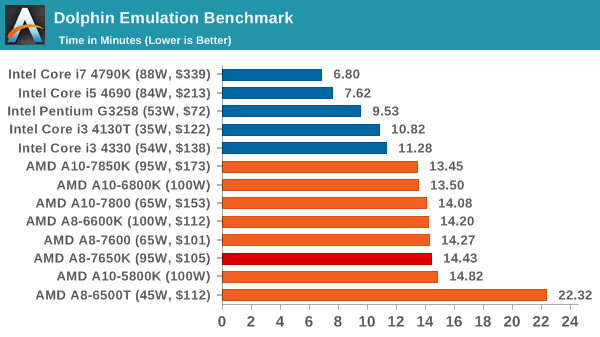
Dolphin likes high IPC and clock frequency, which indicates that the highest clocked APUs perform the best out of AMD here. Because the benchmark is single threaded, even a dual core Intel wins though.
WinRAR 5.0.1: link
Our WinRAR test from 2013 is updated to the latest version of WinRAR at the start of 2014. We compress a set of 2867 files across 320 folders totaling 1.52 GB in size – 95% of these files are small typical website files, and the rest (90% of the size) are small 30 second 720p videos.

The varied-thread workload of WinRAR seems to vary between the dual core Intels and the dual module AMD chips, showing that threads matter.
3D Particle Movement
3DPM is a self-penned benchmark, taking basic 3D movement algorithms used in Brownian Motion simulations and testing them for speed. High floating point performance, MHz and IPC wins in the single thread version, whereas the multithread version has to handle the threads and loves more cores.

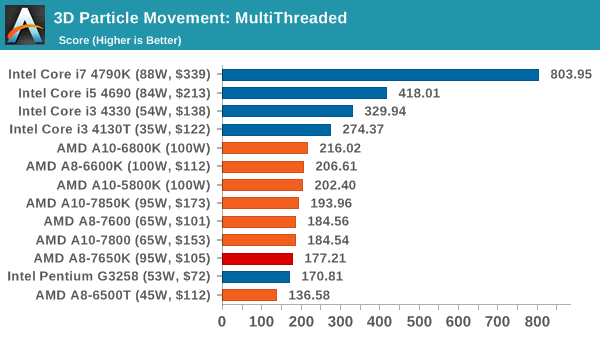
In this nieve benchmark, the compiler prefers x87 style commands which AMD's Bulldozer based architectures isn't too fond of. This benchmark is meant to be a representation of crude scientific code, similar to that used in a research lab. Ultimately, Bulldozer architectures such as Kaveri prefer specific commands, especially when dealing with basic math.
FastStone Image Viewer 4.9
FastStone is the program I use to perform quick or bulk actions on images, such as resizing, adjusting for color and cropping. In our test we take a series of 170 images in various sizes and formats and convert them all into 640x480 .gif files, maintaining the aspect ratio. FastStone does not use multithreading for this test, and results are given in seconds.
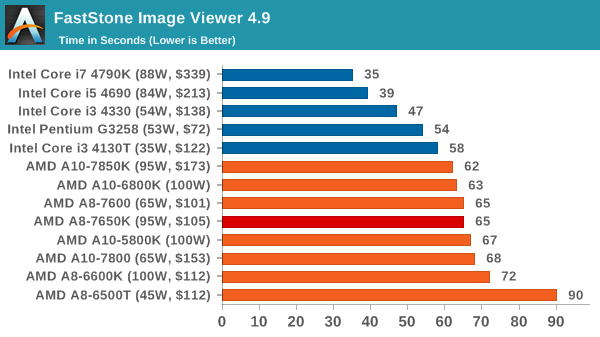
Web Benchmarks
On the lower end processors, general usability is a big factor of experience, especially as we move into the HTML5 era of web browsing. For our web benchmarks, we take four well known tests with Chrome 35 as a consistent browser.
Sunspider 1.0.2

Mozilla Kraken 1.1

WebXPRT
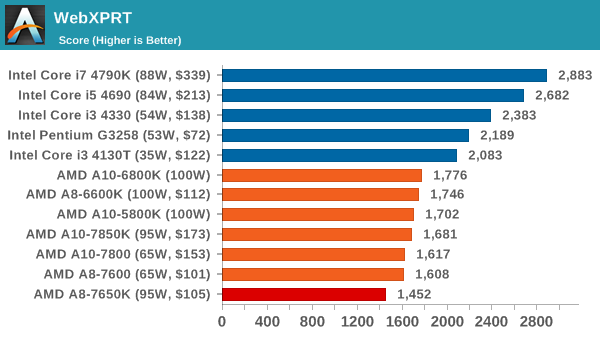
Google Octane v2
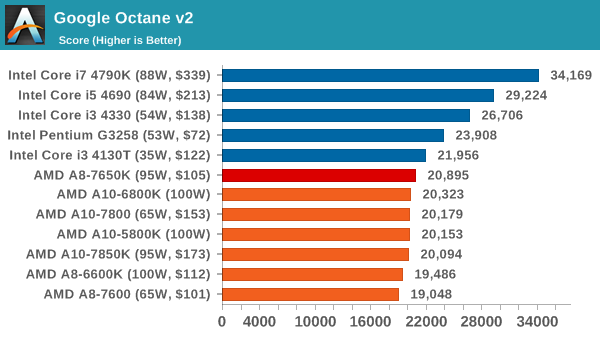










177 Comments
View All Comments
TrackSmart - Wednesday, May 13, 2015 - link
This comment is for Ian Cutress,First, thank you for the review, which was rich with performance figures and information. That said, something seems missing in the Conclusion. To be precise, the article doesn't really have a clear conclusion or recommendation, which is what many of us come here for.
It's nice to hear about your cousin-in-law's good experiences, but the conclusion doesn't clearly answer the key question I think many readers might have: Where does this product fit in the world of options to consider when buying a new processor? Is it a good value in its price range? Should it be ignored unless you plan to use the integrated graphics for gaming? Or does it offer enough bang-for-the-buck to be a viable alternative to Intel's options for general non-gaming usage, especially if motherboard costs are considered? Should we consider AMD again, if we are in a particular niche of price and desired features?
Basically, after all of your time with this chip and with your broader knowledge of the market offerings, what is your expert interpretation of the merits or demerits of considering this processor or its closely related AMD peers?
Nfarce - Thursday, May 14, 2015 - link
" Ultimately AMD likes to promote that for a similarly priced Intel+NVIDIA solution, a user can enable dual graphics with an APU+R7 discrete card for better performance."I have *long* wondered why Intel and Nvidia don't get together and figure out a way to pair up the on-board graphics power of their CPUs with a discrete Nvidia GPU. It just seems to me such a waste for those of us who build our rigs for discrete video cards and just disable the on-board graphics of the CPU. Game developers could code their games based on this as well for better performance. Right now game developer Slightly Mad Studios claims their Project Cars racing simulation draws PhysX from the CPU and not a dedicated GPU. However, I have yet to find that definitively true based on benchmarks...I see no difference in performance between moving PhysX resources to my GPUs (970 SLI) or CPU (4690K 4.7GHz) in the Nvidia control panel in that game.
V900 - Thursday, May 14, 2015 - link
Something similar to what you're describing is coming in DX12...But the main reason they haven't is because unless youre one of the few people who got an AMD APU because your total CPU+GPU budget is around 100$ it doesn't make any sense.
First if all, the performance you get from an Intel igpu in a desktop system will be minimal, compared to even a 2-300$ Nvidia card. And secondly, if you crank up the igpu on an Intel CPU, it may take away some of the CPUs performance/overhead.
If we're talking about a laptop, taking watts away from the CPU, and overall negatively impacting battery life will be even bigger drawbacks.
Nfarce - Thursday, May 14, 2015 - link
"But the main reason they haven't is because unless youre one of the few people who got an AMD APU because your total CPU+GPU budget is around 100$ it doesn't make any sense."Did you even read the hardware I have? Further, reading benchmarks from the built in 4600 graphics of i3/i5/i7 CPUs shows me that it is a wasted resource. And regarding impact on CPU performance, considering that higher resolutions (1440p and 4K) and higher quality/AA settings are more dependent on GPU performance than CPU performance, the theory that utilizing onboard CPU graphics with a dedicated GPU would decrease overall performance is debatable. I see little gains in my highly overclocked 4690K running at 4.7GHz and running at the stock 3.9GHz turbo frequency in most games.
All we have to go on currently is 1) Intel HD 4600 performance alone in games, and 2) CPU performance demands at higher resolutions on games with dedicated cards.
UtilityMax - Friday, May 15, 2015 - link
I am guessing that they didn't get together because dual-graphics is very difficult to make to work right. AMD is putting effectively the same type of GPU cores on the discrete GNUs and integrated APUs, and it still took them a while to make it work at all.V900 - Thursday, May 14, 2015 - link
I guess one thing we all learned today, besides the fact that AMDs APUs still kinda blow, is that there is a handful of people, who are devoted enough to their favorite processor manufacturer to seriously believe that:A: Intel is some kind of evil and corrupt empire ala Star Wars.
B: They're powerful enough to bribe/otherwise silence "da twooth" among all of Anandtech and most of the industry.
C: 95% of the tech press is corrupt enough to gladly do their bidding.
D: Mantle was an API hardcoded by Jesus Christ himself in assembler language. It's so powerful that if it got widespread, no one would need to buy a new CPU or GPU the rest of this decade. Which is why "they" forced
V900 - Thursday, May 14, 2015 - link
Which is why "they" forced AMD to cancel Mantle. Then Microsoft totally 110% copied it and renamed it "DX12".Obviously all of the above is 100% logical, makes total sense and is much more likely than AMD releasing shoddy CPUs the last decade, and the press acknowledging that.
wingless - Thursday, May 14, 2015 - link
AMD DOMINATION!!!!! If only the charts looked like that with discrete graphics as well....Vayra - Friday, May 15, 2015 - link
Still really can't see a scenario where the APU would be the best choice. Well, there may be one: for those with a very tight budget and wish for playing games on PC regardless. But this would mean that AMD has designed and reiterated a product that would only find its market in the least interesting group of consumers: those that want everything for nothing... Not really where you want to be.UtilityMax - Friday, May 15, 2015 - link
Well, right now arguably, if one has $500 bucks or less for a gaming PC build, it would be better to buy a Playstation 4. High end builds is where the money is in the enthusiast gaming market.